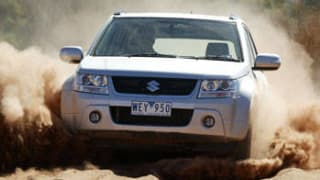
Suzuki Grand Vitara 2009 review
Suzuki's original Grand Vitara was a bit like that kid. Considered by many to be too much of an...
Browse over 9,000 car reviews
High school chemistry and a compound found in urine are helping the new Mazda CX-7 reduce emissions from its diesel engine. In what Mazda is claiming as a first on the Australian passenger car market, the CX-7 is fitted with a system that injects the liquid urea – a compound found in urine -- into the toxic nitrogen oxide exhaust gases, turning them into harmless nitrogen and water. It’s a similar system to those seen on heavy vehicles here, but is also on many passenger cars overseas.
The urea is held in a separate tank that lasts more than 20,000km and can be refilled as part of the normal service cycle for a charge of around $150. If the tank gets close to empty, the vehicle’s speed is restricted. And if it empties completely, the vehicle will not restart. The CX-7 also has a particulate filter to reduce the amount of soot belched by the diesel engine, and the two systems help the vehicle meet coming emissions regulations in Europe and the Unites States, where the urea technology will become mandatory in the near future.
The diesel is one of two new engines – and a two-wheel drive system -- joining the carryover turbocharged petrol engine al-wheel drive that was the only one available in the current range. And Australia is the only market to get all three engines, Mazda says. The 2.2-litre turbodiesel is the MRZ that debuted in the Mazda6, retuned to match the characteristics of the CX-7. It develops 127kW at 3500rpm and 400Nm at 2000rpm, with those outputs getting to the all-wheel drive system via a six-speed manual. It posts a fairly frugal 7.6l/100km economy and 202g/km of CO2 emissions.

On the other end of the scale, the new entry-level engine is the 2.5-litre petrol unit from the Mazda6, mated to a five-speed sequential automatic driving the front wheels and developing 120kW at 6000rpm and 205Nm at 2000rpm, with official economy of 9.4/l/100km and emissions of 223g/km. The range is topped by the carryover 2.3-litre turbocharged petrol unit in both the Classic Sports and Luxury Sports, which has been given some brake drag, transmission, torque control and idle speed revisions to improve economy by close to 8 per cent. A six-speed sequential automatic drives all wheels with 175kW at 5000rpm and 350Nm at 2500rpm. This is the thirstiest – and grubbiest -- of the units, with economy of 11.5l/100km and emissions of 273g/km.
It would be hard to fault Mazda’s design direction over the past couple of years, and the facelifted CX-7 serves to improve on the current model with a more aggressive nose and more pronounced lines around the front fascia and light clusters.
The interior is similarly improved, with better quality materials, a new sporty steering wheel with clusters of remote controls, electric-blue accented instruments and a subtle curve over the mid-dash instrument binnacle. But there’s still something a little awkward around the rear end, particularly where the C-shaped Led clusters in the tail-lights seems to sit oddly in the squared-off bezels.
The entry level Classic, with two-wheel drive and the 2.5-litre petrol engine, is priced at $33,990, but given decent basic spec that includes stability and traction control, anti-lock brakes with brake-force distribution and emergency brake assist, front side and curtain airbags, reversing camera, music player jack for the audio system and cruise control.
Next step up is the Classic Sports at $38,990, which is basically the same spec with the higher-powered petrol engine. The new Diesel Sports sits at $43,640, with extra kit including satnav, 19-in wheels and sunroof. The Luxury Sports at $45,990 is similar spec matched with the high petrol drivetrain.
Sales and market
More than 14,000 CX-7s have been sold here since the Australian launch in 2006, and Mazda expects to keep up that rate of roughly 400 per month – or better. “At 400 a month we have a very solid business case,” marketing manager Alastair Doak says. “And if the demand is there for 500 or 600 – we’ll just have to ask the factory if they can supply. “We expect 2WD to connect to a whole new customer, and it could be up to 30 per cent of sales. Offroad ability is not a main reason for purchase for the significant majority of buyers in this segment. They want an SUV to sit up high, giving them a feeling of safety and security in the urban jungle. “Up until now the Luxury model has been about 80 per cent of sales, but (with the new additions) it will be around 50 per cent, with the Classic Sports and the new Diesel Sports taking 10 per cent each.”
There’s little doubt people will be interested in the new diesel drivetrain, but what might be a hurdle is the lack of an automatic transmission in a market that is increasingly moving that way. Not that there’s a problem with the six-speed manual. It’s got a nicely weighted throw, snicks into the slots with definite action, and is reasonably smooth and fast.
It’s a pleasure to use out on the open road, but you don’t want to be doing all that rowing every 50 metres in city traffic. But except for in the very low rev range, there’s no shortage of go in the engine, and the manual’s gearing is well suited to stir it into some sturdy action.
The active torque-split all-wheel drive system has always been pretty capable, but the lack of any meaningful ground clearance will keep adventuring to a minimum. It’s impossible to be enthusiastic about the entry-level petrol unit, which struggled to haul the CX-7 up most steep slopes – despite its 1600kg being 350kg less than the diesel -- and demanded tactics and a tailwind for any urgent overtaking.
The gearing is tuned for economy, and if it were any more laid back it would be horizontal. And even Masashi Otsuka -- the program manager for the facelifted softroader – admits that the two-wheel drive entry level engine will really only be right for those who want to stay within city limits. “This is a good car for heavy traffic, with good fuel consumption. And so good for ladies and families in the city. Very comfortable … but not so good for outside the city,” Otsuka says.
He says Mazda also analysed the body of the current model and were able to identify some weak points around the door sills and upper apertures, so these have been amended and rigidity has increased by five per cent. These improvements – in tandem with the well-calibrated McPherson front and multi-link rear suspension – give a ride that is remarkable in the two variants we tested for being both compliant and responsive.
We took both the baseline and the diesel models over stretches of often patchy bitumen, and a small stint of gravel, and neither of them were unsettled or jarring. But nor did they wallow around.
And despite the rough under the wheels, both cabins were impressively quiet, with only a bit of tyre roar suggesting what was going on outside. There are some clever touches around the cabin, like the sunvisor extenders that should really be standard on every vehicle in Australia. The only annoyances we found on launch were the wide a-pillars cutting into visibility, and just a single drop of rain on the reversing camera rendering it completely useless. They’re small points, but important ones on a vehicle that aims pretty hard for family attention.
| Vehicle | Specs | Price* | |
|---|---|---|---|
| Classic (FWD) | 2.5L, ULP, 5 SP AUTO | $7,370 – 10,340 | 2009 Mazda CX-7 2009 Classic (FWD) Pricing and Specs |
| Classic (4x4) | 2.3L, PULP, 6 SP AUTO | $6,050 – 8,580 | 2009 Mazda CX-7 2009 Classic (4x4) Pricing and Specs |
| Classic Sports (4x4) | 2.3L, ULP, 6 SP AUTO | $7,480 – 10,560 | 2009 Mazda CX-7 2009 Classic Sports (4x4) Pricing and Specs |
| Diesel Sports (4x4) | 2.2L, Diesel, 6 SP MAN | $6,380 – 8,910 | 2009 Mazda CX-7 2009 Diesel Sports (4x4) Pricing and Specs |
$5,999
Lowest price, based on 34 car listings in the last 6 months